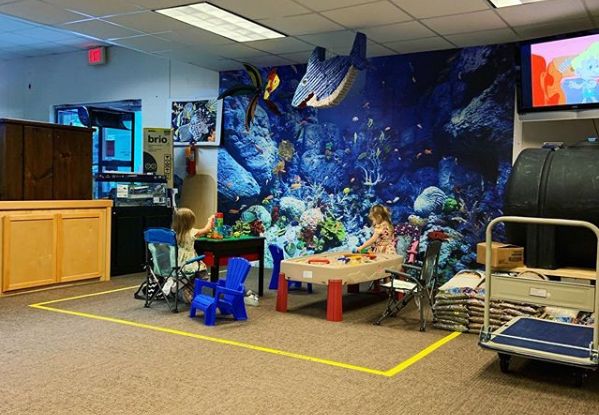
Bring the kids. We've got you covered.

Web Home of Just Fish in Biloxi, MS

Bring the kids. We've got you covered.

A long time coming, but Just Fish/Pass Road Pet Center, after decades at 1939 Pass Road, is moving to a new location, just up the street at 2306 Pass Road. A larger, more modern building, and plenty of (paved) parking available!

Before the amazing transformation...
We'll always remember the old store and the many memories and friends we first made there.

Marine aquarium protein skimmers, also known as foam fractionators, are devices used to remove organic waste from the water in a marine aquarium. They work by creating a column of water through which aquarium water is passed, causing organic molecules and other waste to stick to the surface of rising air bubbles. The bubbles then rise to the top of the column and are collected in a collection cup, where the waste is removed from the aquarium.
Protein skimmers are especially useful in saltwater aquariums, where the waste produced by fish and invertebrates can quickly accumulate and cause a variety of problems, including poor water quality, algae growth, and decreased oxygen levels. They are often considered essential equipment for maintaining a healthy and stable marine aquarium.
There are many different types of protein skimmers available, ranging from simple hang-on-back models to more complex, in-sump or external models. The effectiveness of a protein skimmer depends on a number of factors, including the size of the aquarium, the number of fish and other inhabitants, and the types of food being fed to the animals in the tank.
In addition to their effectiveness at removing organic waste, protein skimmers can also help to increase the dissolved oxygen levels in an aquarium, which can be especially beneficial for sensitive or delicate marine animals.
Overall, a high-quality protein skimmer is an important investment for anyone who wants to maintain a thriving and healthy saltwater aquarium.
Magnetic aquarium algae cleaners are tools used for cleaning the walls of aquariums. They consist of two magnets, one inside the aquarium and the other outside, with a scrubber pad attached to the inside magnet. The two magnets are attracted to each other, which allows the scrubber pad to move around on the inside of the tank while the user controls the outside magnet.
Magnetic aquarium algae cleaners are typically used to remove algae, debris, and other contaminants from the walls of an aquarium. They are especially useful for cleaning the walls of larger tanks, as they allow the user to clean the entire surface without having to reach into the tank.
When using a magnetic aquarium algae cleaner, it's important to choose the right size and strength for your tank. A cleaner that's too small or weak may not be effective, while one that's too strong could damage the glass or acrylic of your tank.
Magnetic aquarium algae cleaners are a convenient and effective tool for maintaining the cleanliness of your aquarium. However, it's important to use them properly and to follow all safety precautions to avoid harming your fish or damaging your tank.
Gyre flow is a type of water flow that is commonly used in marine aquariums to simulate natural ocean currents. It involves creating a circular flow pattern in the aquarium that helps to distribute nutrients and oxygen evenly throughout the tank, and also helps to remove waste and debris.
The gyre flow is typically achieved by using a specialized water pump that can produce a strong, laminar flow of water that creates a circular pattern in the tank. The flow is then directed in such a way that it creates a gentle, yet powerful current that moves water from one side of the aquarium to the other, creating a continuous circular motion.
One of the benefits of using gyre flow in marine aquariums is that it can help to reduce dead spots and stagnant areas where debris and waste can accumulate. It can also help to promote the growth of beneficial bacteria and other microorganisms that are essential for maintaining a healthy aquatic ecosystem.
However, it's important to note that gyre flow may not be suitable for all types of marine organisms. Some species may prefer a gentler flow of water, while others may require a stronger current to thrive. Additionally, some types of aquarium setups may not be able to accommodate the specific needs of a gyre flow system.
Overall, if you're considering using gyre flow in your marine aquarium, it's important to do your research and consult with an experienced aquarium professional to determine whether it's the right choice for your specific needs and goals.
Live rock is a popular and essential component of marine aquariums. It is basically a type of rock that is harvested from the ocean and contains a diverse community of living organisms, such as bacteria, algae, sponges, corals, and other invertebrates.
The primary function of live rock in a marine aquarium is to provide a natural and stable environment for the marine animals to thrive. It helps to establish and maintain the biological filtration system in the aquarium, which is necessary for breaking down the harmful waste products produced by fish and other inhabitants.
Live rock also serves as a source of food and shelter for various marine creatures. The porous structure of the rock provides hiding places and nesting sites for fish and invertebrates, which helps to reduce stress and increase their overall health.
In addition, live rock adds to the overall aesthetic appeal of the aquarium. The various shapes and colors of the organisms living on the rock can create a beautiful and natural-looking environment that is pleasing to the eye.
When adding live rock to a new aquarium, it is important to ensure that it is properly cured to remove any excess organic matter or harmful organisms that could harm the tank's inhabitants. Curing can take several weeks or even months and requires regular water changes and testing to ensure that the water parameters are stable and safe for the aquarium's inhabitants.
Overall, live rock is an important and beneficial addition to a marine aquarium, providing both aesthetic and practical benefits to the tank's inhabitants.
Ultraviolet (UV) sterilizers are commonly used in marine aquaria as a method of controlling and reducing the growth of harmful microorganisms, such as bacteria, viruses, and parasites. These organisms can cause diseases and infections that can be harmful or even fatal to the marine animals living in the aquarium.
UV sterilizers work by exposing the water flowing through them to high-intensity UV light, which destroys the genetic material of the microorganisms, preventing them from reproducing and causing harm. This can help to improve the overall health and wellbeing of the marine animals in the aquarium.
UV sterilizers are often used in conjunction with other forms of filtration and water treatment, such as protein skimmers and mechanical filters. It is important to note that UV sterilizers do not replace the need for regular maintenance and water changes, but rather serve as an additional tool to help maintain a healthy aquarium environment.
When selecting a UV sterilizer for a marine aquarium, it is important to choose one that is appropriate for the size of the tank and the flow rate of the water. It is also important to regularly clean and maintain the UV sterilizer to ensure that it is working properly and effectively.
Overall, the use of UV sterilizers can be a beneficial addition to a marine aquarium, helping to maintain a healthy and thriving environment for the marine animals living within it.